Beagle Weight and Growth Chart
Posted: 06/01/2025 | BY: Humberto Noguera | Categories: Dog , Dog Weight and Growth Chart
The Beagle is a centuries-old hunting dog that hails from England. They are intelligent, energetic, and bright animals who are playful family dogs. Beagles are known as “foot hounds” in England because they track down rabbits and hares on foot. Today, you can find these loyal companions in homes worldwide. They serve both working purposes (like tracking) and just being an adorable companion for families with children. With their keen sense of smell, this breed is on alert with every step. It’s hard not to get distracted by this pup’s outgoing personality when they have such enthusiasm for life.
If you have a Beagle, then it is likely that your pup always wants to know what’s going on. They are very vocal and passionate about everything, and as a working dog, this breed requires plenty of daily exercises. Best known for its vocal howls, the Beagle is intelligent enough that, with proper training, vocalization can be controlled so as not to become a neighborhood nuisance.
It is essential to monitor your pup’s growth rates so that you can keep an eye on their weight and health. Healthy Beagle puppies become happy adult dogs. Early monitoring of dietary needs, weight, and height ensure your puppy grows healthy and strong.
You need to know when your Beagle puppy will grow up and how much he should weigh as a mature dog. This information allows you to keep tabs on your puppy’s growth rate so that it stays within an appropriate range for his breed type.
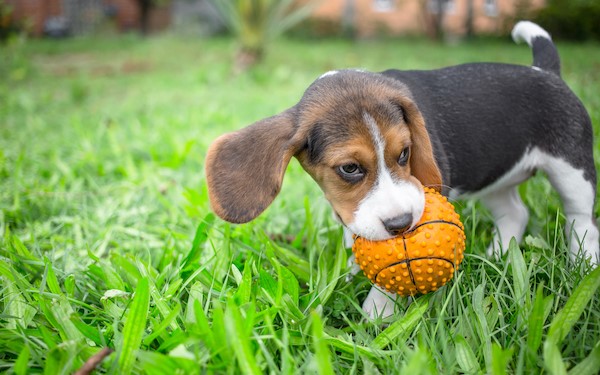
Do you own a Beagle puppy?
The Beagle is considered a small breed hound dog. If you own a Beagle puppy, you might wonder when a Beagle stops growing? What is the average size and weight for this breed? How much does a full-grown Beagle weigh? How much should a Beagle weigh?
There are two varieties of Beagles, one with an average height between 13-15 inches tall and another shorter type that measures under 13 inches. The American Kennel Club recognizes both sizes but does not provide any distinctions based on gender. Miniature or pocket Beagles are also an option for smaller living environments; however, the AKC does not formally recognize the mini Beagle as an official dog breed.
Your Beagle’s adult height largely determines their healthy weight, which can vary by about 10 pounds depending on the size classification. If you purchased your pup from a breeder or pet store and are unsure of its size assignment, ask the source. Otherwise, you can measure your pup yourself or speak with your veterinarian about their opinion.
Remember, these numbers are just estimates, and all puppies grow at different rates. Don’t worry if your Beagle is slightly ahead or behind in these numbers. Always consult with the vet if you have concerns about your Beagle’s growth.
Still not sure how much an adult size Beagle should weigh? No worries! We’ve got all of your answers with our Beagle growth chart below.
One of the best ways to help your beagle live a long and healthy life is to enroll them into a pet insurance plan. This ensures you will always be able to afford the care they need should they become seriously ill or injured.
Beagle Puppy Growth Patterns: How Much Does a Beagle Breed Weigh?
Your Beagle is a growing puppy. Oversee his height and weight to ensure he’s meeting the statistical averages for both qualities. Still, if he is falling far short, then there may be some genetic or environmental conditions affecting the Beagle’s growth.
The diet that is right for your Beagle puppy depends on the needs and personality of this lively breed. Their active lifestyle means their diet must be carefully selected. Therefore, finding a healthy nutritional balance becomes essential in ensuring your dog’s long-term health and success. A Beagle puppy needs to consume the proper amount of puppy food and adequate nutrition to grow up properly. These elements allow them a lean, muscular build with moderate growth rates, ideal for both the shorter and taller versions.
The best preventative treatment for your Beagle includes veterinary checkups at 6 and 12 months old. Regular checkups can help you avoid any potential growth issues, leading to stunted growth or obesity in adulthood, a constant concern for many Beagle owners. Due to their love of food and slower metabolisms, Beagles are prone to overeating and gaining weight more than other smaller breeds. This drive is all fine and well when your Beagle is young. However, as the dog ages and his metabolism slows down, the amount of dog food eaten daily needs to change, or obesity will result. A balanced diet and a healthy weight are necessary for growing Beagle puppies.
So how big will your Beagle pup get? What is a Beagle’s final size? Use our Beagle weight chart below from a month-old size for the little guys all the way up until adulthood. Then you can make sure your dog doesn’t experience any unexpected weight gain or loss during the Beagle growth stages, which may cause health problems later on in life!
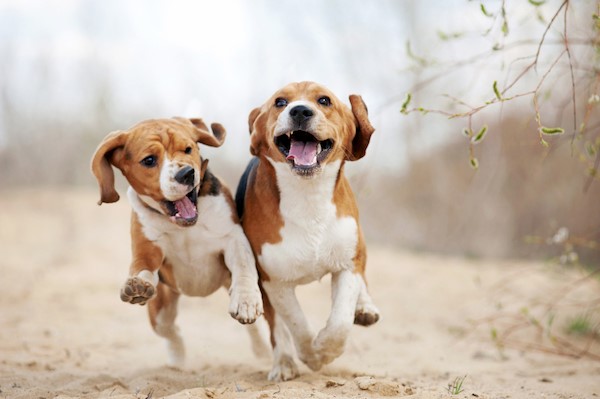
Male Beagle Growth Chart from Puppy to Adult Beagle
Male Beagles reach ideal adult weight within 18 months and adult height by 8 months. The full-grown male Beagle grows between 13 to 15 inches tall and weighs between 20 to 25 pounds, depending on which size category the Beagle is in. Beagles 13 inches or shorter tend to be closer to 19 to 22 pounds.
When it comes to the perfect pup, you want one that’s healthy and happy! The Beagle puppy’s weight chart below shows what healthy, appropriate weights look like for Beagle males from average puppy size through adulthood.
| Age | Smaller Beagle Weight (up to 13”) | Larger Beagle Weight (13 – 15”) |
| 1 month | 2 – 3 pounds | 3 – 4 pounds |
| 2 months | 3 – 5 pounds | 4 – 7 pounds |
| 3 months | 7 – 10 pounds | 8 – 11 pounds |
| 4 months | 8 – 11 pounds | 9 – 12 pounds |
| 5 months | 9 – 12 pounds | 10 – 13 pounds |
| 6 months | 12 – 17 pounds | 14 – 18 pounds |
| 7 months | 14 – 16 pounds | 16 – 20 pounds |
| 8 months | 16 – 20 pounds | 20 – 26 pounds |
| 9 months | 16 – 20 pounds | 20 – 29 pounds |
| 10 months | 16 – 20 pounds | 20 – 29 pounds |
| 11 months | 16 – 20 pounds | 20 – 30 pounds |
| 12 months/1 year | 16 – 22 pounds | 20 – 30 pounds |
| 18 months | 16 – 22 pounds | 20 – 30 pounds |
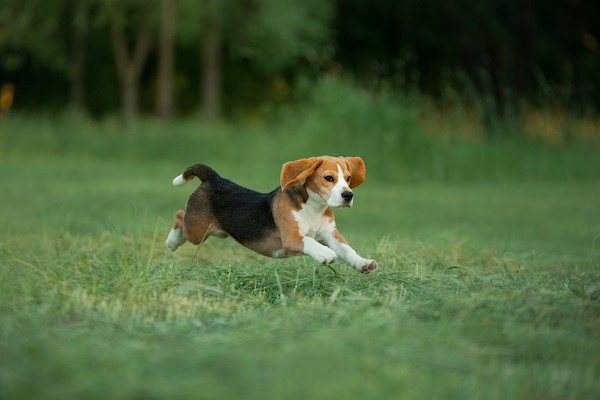
Female Beagle Growth Chart from Puppy to Adult Beagle
The average height and weight for female Beagles should be settled between 12 to 18 months. A full-grown Beagle will measure 11 to 15 inches tall with an average weight of 19 to 24 pounds, which can vary depending on whether they are a tall or short breed Beagle.
What happens if your Beagle becomes pregnant in adulthood?
The pregnant dog’s body undergoes significant changes during pregnancy, and the adult weight will change accordingly. A 15-20% gain is standard for most female dogs as they prepare to give birth and nurse puppies. Always wait until your female pup is an adult dog before breeding them. This helps prevent complications during birth to both the mother and puppies.
The growth chart below displays the healthy growth patterns for a female Beagle:
| Age | Smaller Beagle Weight (up to 13”) | Larger Beagle Weight (13 – 15”) |
| 1 month | 2 – 3 pounds | 4 – 6 pounds |
| 2 months | 3 – 5 pounds | 4 – 7 pounds |
| 3 months | 6 – 9 pounds | 7 – 10 pounds |
| 4 months | 7 – 10 pounds | 8.5 – 12 pounds |
| 5 months | 8.5 – 12 pounds | 9 – 13 pounds |
| 6 months | 10 – 14 pounds | 12 – 16 pounds |
| 7 months | 12 – 15 pounds | 14 – 18 pounds |
| 8 months | 13 – 16 pounds | 15 – 19 pounds |
| 9 months | 16 – 20 pounds | 15 – 20 pounds |
| 10 months | 16 – 20 pounds | 16 – 23 pounds |
| 11 months | 16 – 20 pounds | 18 – 22 pounds |
| 12 months/1 year | 16 – 22 pounds | 19 – 24 pounds |
| 18 months | 16 – 22 pounds | 20 – 24 pounds |
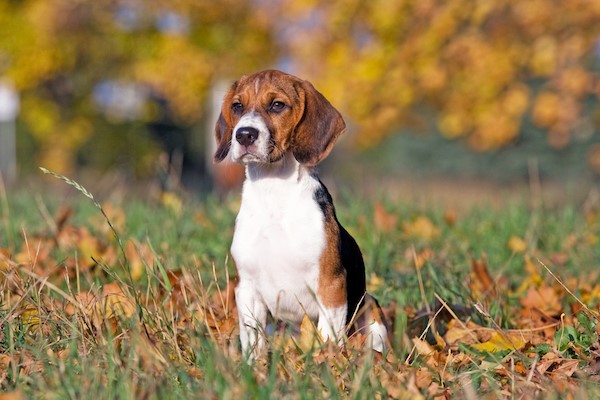
When Do Beagles Stop Growing?
The Beagle is a small and muscular canine. It takes time for this breed to grow into adulthood, with some dogs not reaching their full height or weight until they’re 18 months old! That’s why tracking what kind of developmental milestones your puppy experiences during their first year is critical. Tracking will help you know if any signs might point towards lifelong health problems for your pup down the line.
Your pup will grow and change steadily throughout his first year. Expect his puppy weight to gradually increase as he experiences this growth curve. Use our weight chart to keep track of how much your Beagle pup is growing or adjusting at any given time!
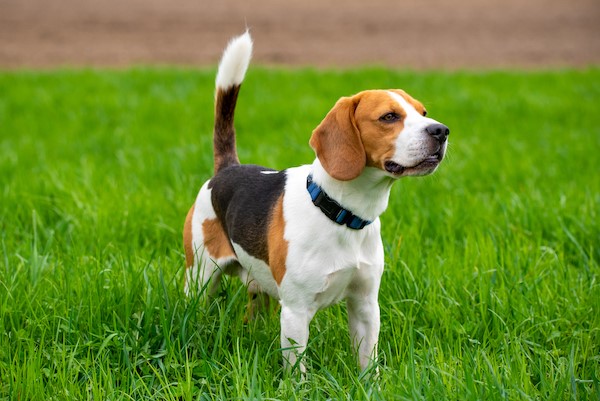
Beagle Lifespan
Just how many years can you expect to enjoy with your fur baby? In general, the Beagle lifespan is between 12 to 15 years. What’s important to mention is that proper care and nutrition can help to extend your pup’s life expectancy. For instance, keeping your Beagle a healthy weight is important to help prevent obesity, arthritis and other chronic diseases. You also want to be certain to get regular dental checkups as many diseases begin in the mouth. So keep those gums and pearly whites clean! And speaking of diseases…
Beagle Health Issues
The most important thing to remember about your Beagle is that they need care and attention like any other family member. This means taking them for regular checkups at the vet, making sure their immunizations stay up-to-date so you can protect them from illness and disease. Annual physicals for your pup are great ways to find early signs of medical trouble and treat it before it becomes debilitating and life-threatening. As with any purebred canine, the Beagle is prone to developing more medical conditions than other breeds. Often these issues are hereditary or affected by the dog’s environment. Here are the most common Beagle illnesses:
Cherry eye
When a dog’s third eyelid becomes swollen and inflamed, causing it to protrude from its lower lid, the condition is called glandular hypertrophy or “cherry eye.” The most successful treatment for this condition is the surgical removal of any enlarged glands to avoid scarring or other complications.
Glaucoma
Glaucoma is a condition in which the pressure inside of a dog’s eye becomes too high due to excess liquid (aqueous humor) that builds up and cannot drain away naturally. This leads to canine blindness unless treated. Symptoms of canine glaucoma in Beagles include:
- pupils of different sizes.
- the appearance of vessels within an eye’s white layer.
- squinting, swollen, or bulging eyes.
- tearing.
This condition can be treated with medication such as ophthalmic drops; however, if it is severe, then surgery may need to take place.
Idiopathic epilepsy
Epilepsy is a chronic neurological disorder that causes sudden, uncontrollable seizures in dogs. There are partial (focal) seizures and generalized (grand mal) seizures, which affect both sides of the brain and every part of the entire body. Idiopathic epilepsy involves seizures with no known cause, despite veterinary examinations and bloodwork.
Genetics appear to be responsible for idiopathic epilepsy in many Beagles. It’s essential to get your dog’s epilepsy treated as soon as possible. If left untreated, the condition may cause permanent damage and, in some cases, lead to death. Seizures can be controlled with anti-seizure medications and changes in food to a nutrient rich diet.
Hypothyroidism
Hypothyroidism is an autoimmune disorder that attacks the thyroid gland in dogs. The body believes there’s something harmful in the thyroid and will try to replace hormones with fat cells, leading to Thyroid Gland Atrophy. This medical condition is thought to be due to inbreeding. Fortunately, hypothyroidism is manageable through medication and your dog’s diet changes.
Diabetes
Just like people, dogs can get either Type 1 or 2 diabetes. Both types have to do with insulin production in the pancreas. Canines suffering from this genetic condition will have an inadequate amount of naturally-occurring hormones that control blood sugar levels. Beagles have a higher chance of developing Type 1 diabetes, which is genetic. However, suppose they become overweight and continue to eat unhealthy foods for an extended period. In that case, it could lead a dog to develop diabetes.
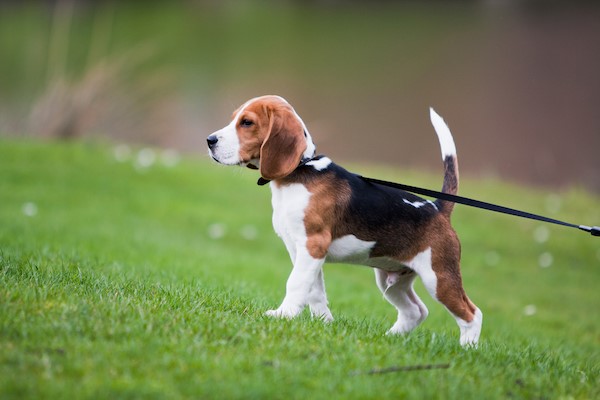
Have a Beagle? Protect them with pet insurance.
Your Beagle is a bundle of joy, but he can develop health problems over his lifetime. It’s important to know that some breeds are more susceptible than others due to genetic issues or environmental factors like diet. If your pup develops cherry eye or epilepsy, will you have veterinary care and medication funds? Pet insurance ensures that you don’t have to worry about finances; you only need to worry about what’s most important: your dog!
With pet health insurance, you can rest assured that your pup will be taken care of should he need medical treatment. Dog owners who purchase coverage from insurance providers can receive up to 90% reimbursement on veterinary costs, depending upon the type of insurance policy they are buying.
Get peace-of-mind for yourself and get a free pet insurance quote today to start protecting your beloved Beagle.
DisclaimerThe information contained on this blog is intended for informational and educational purposes only and should not be construed as medical advice. It is not a substitute for professional veterinary care. Always consult with your veterinarian before making any changes to your pet's health care or treatment plan.
The authors of this blog are not veterinarians and do not claim to be experts in pet health. The information provided here is based on our own experiences and research, as well as information from reputable sources. However, we cannot guarantee the accuracy or completeness of this information.
We encourage you to do your own research and consult with your veterinarian before making any decisions about your pet's health.
Previous post
Cane Corso Weight and Growth ChartNext post
Shih Tzu Growth and Weight ChartCompare top pet insurance providers plans.
Enter your dog’s age in years and months to calculate their age equivalent to human years.
Calculate your dog’s ageEnter your cat’s age in years and months to calculate their age equivalent to human years.
Calculate your cat’s age